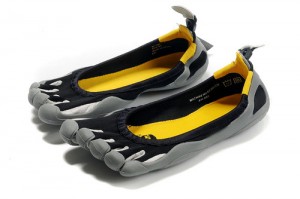Ankle sprains are very common in the practice of sports physiotherapy. However, unfortunately many patients go on to have long term problems. This has lead to the development of many proposed treatments and rehabilitation programs. This article will discuss new research into the use of manual therapy techniques combined with exercises for the rehabilitation of inversion ankle sprains.
Aerobic exercise, particularly in the form of running, has become more popular with the general population over the last few decades. Unfortunately, this increase in healthy exercise may come at a cost with up to 80% of runners reporting a lower limb injury. These trends mean that preventing running injuries is gaining significant importance in the world of sports medicine. One touted intervention that is currently in vogue is adapting the runner’s biomechanics to a forefoot strike pattern or barefoot running technique…
In this episode of the podcast I interview Trent Salkavich. Trent is a Sports Podiatrist and Director of SportsPodiatrists.com.au. He consults from Sydney Sports Medicine Centre, Balmain Sports Medicine and Sydney Sports Med Specialists. He is currently the consulting podiatrist for the Australian Defence Force Academy Barracks, Sydney Apia (formally known as the Medibank) International Tennis Tournament, NSWIS/AIS Tennis players, various AUS/NSW Institute of Sport athletes, and the Australian Wallabies 2011 World cup team.
 TSP009: Footwear Prescription for Running with Trent Salkavich [ 33:18 ] Play Now | Play in Popup | Download
TSP009: Footwear Prescription for Running with Trent Salkavich [ 33:18 ] Play Now | Play in Popup | Download
The shoe industry has evolved most rapidly over the previous decade and will continue to evolve as new technologies and markets are formed. We are in an era where athletes are training in barefoot running shoes and it’s not uncommon for a shoe to carry a microprocessor to play music and/or retain information for further gait evaluation post training. This article aims to unravel the hype and assist physiotherapists on advising the most appropriate footwear for their patients.
Ankle injuries are a ridiculously common sports injury. Ankle injuries are the most common injuries in a wide variety of popular sports. In fact, it has been suggested that ankle injuries account for 10-30% of all sports injuries; 77% of which are lateral ankle sprains. Thus, it goes without saying that knowledge of evidence based management and current best practice is essential for lateral ankle sprains. This article will discuss the current evidence for the use of bracing following acute ankle sprains.
Ankle injuries are a ridiculously common sports injury. Fong et al (2007) found that ankle injuries are the most common injuries in a wide variety of popular sports. It has been suggested that syndesmosis injuries account for about 11% of ankle injuries. Furthermore, ankle syndesmosis injuries (or “high” ankle sprains) have high occurrences during athletic activities, particularly those that involve twisting or cutting activities. Read on for evidence based assessment and diagnosis of ankle syndesmosis injuries.
In this episode of the podcast I interview Karim Khan. Karim Khan is an Associate Professor from the University of British Columbia, and is the editor of the British Journal of Sports Medicine. He has worked with a number of sports at an elite level, as a sports physician, and is well published on the topic of Achilles tendinopathy management. In the interview we discuss
INTRODUCTION Mid-portion (or non-insertional) Achilles tendinopathy has been reported as one of the most common overuse injuries (Maffulli et al., 2003). It is common in those who engage in regular physical activity, which means athletes are particularly susceptible to this condition. Sports physiotherapists who treat regularly treat runners will be aware of its high incidence […]
INTRODUCTION Many of you, I’m sure, will be interested to learn to efficacy of PRP injections for treating athletes with chronic achilles tendinopathies. PRP has gained significant attention of late; in the media, medical community and with our athletes. It seems my athletes are always asking for information on the most effective form of injectional […]
How often do you treat ankles? I know that I treat them every day, and it is likely that you do to. Osteochondral lesions are very underdiagnosed causes of ankle pain and dysfunction. The astute sports physiotherapist should be aware of the hallmarks of this diagnosis. This article aims to present an overview of the evidence based assessment and management of osteochondral lesions of the ankle.
In the past this site has featured some lighter, colloquial blog posts. These articles discuss issues related to the greater physiotherapy community. Thus, I present a few mantras I have heard, adapted or made up for the physios to live by in the coming year.
Radial tunnel syndrome is rare, it is challenging to differentially diagnose and can be a monster to manage. If you have a recalcitrant case of tennis elbow then this post will interest you! This article discusses the best available evidence for assessment and management of radial tunnel syndrome.









